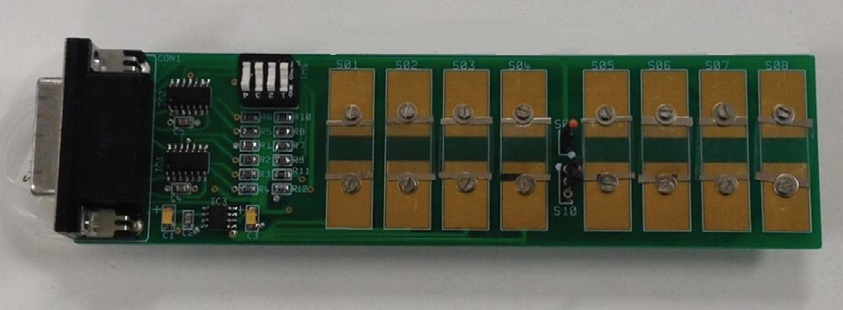May 15 2020
A new compact sensor system designed by researchers from Russia and Italy can execute the functionality of the electronic nose. The researchers have also come up with a reproducible technology for its manufacture.
 The electronic nose matrix board with eight sensors. Image Credit: Skoltech.
The electronic nose matrix board with eight sensors. Image Credit: Skoltech.
This device has been developed as flexible electronics with the ability to analyze exhaled air, and identify pathologies of the respiratory tract and organs.
Experiments showed that the device has high accuracy in identifying patients with chronic obstructive pulmonary disease (COPD), an inflammatory disease that affects the respiratory tract, increasing the risk of complications during COVID-19 infection.
The study has been reported in the Advanced Healthcare Materials journal. A grant from the Russian Science Foundation (RSF) supported the development of the sensor system.
Chronic obstructive pulmonary disease (COPD) occurs in the bronchial mucosa as a response to pathogenic external factors and results in a negative influence on the functions of the respiratory tract. Since the inhaled airflow is limited in people with COPD, they cannot receive the required amount of oxygen.
In general, COPD is caused by gases and volatile particles like tobacco, dust, silicon particles, cadmium, and many more. The techniques for identifying this disease are complicated and time-intensive, which could pose a risk to the patient’s health.
Mass spectroscopy, gas chromatography, and other such traditional methods for breath analysis are time-consuming and costly, and thus new low-cost, quicker techniques are required for testing.
COPD is an emergent issue as the disease could result in the restriction of physical performance and eventually disability of patients. It is crucial to note that people suffering from COPD are most prone to complications upon being infected with COVID-19.
Malfunctioning of human organs causes a change in a number of processes in the metabolism, which affects the composition of exhaled air. Its analysis can be used to identify diseases of the respiratory system as well as other internal organs, such as the stomach. The proposed concept of the electronic nose allows for operational monitoring and preliminary detection of diseases in just a few minutes.
Ivan Bobrinetskiy, Doctor of Science and Leading Research Associate, National Research University of Electronic Technology
Bobrinetskiy, who is also the project manager for the Russian Science Foundation grant, added, “At the same time, the sensors are reusable, and the basic data and the identification of possible pathologies of organs are transferred from the device to digital mode using methods of statistical data analysis, including the capabilities of artificial intelligence.”
The new sensor system is based on modified carbon nanotubes (CNTs), which enable the electronic nose to integrate several preferred properties. For instance, carbon nanotubes can be used to make flexible conductive films. Films such as those are required to offer the system with a layer with a specified electronic structure, which will be useful for the working of the device.
CNTs were synthesized by aerosol chemical vapor deposition and deposited in the form of thin transparent and conductive films. This technology is highly reproducible, easily scalable and allows applying films of nanotubes to any surface.
Albert Nasibulin, Professor, Skolkovo Institute of Science and Technology
Nasibulin is also a professor at the Russian Academy of Sciences. The creation of the CNT manufacturing technology for the sensor system is also funded by a grant from the Russian Science Foundation.
The effectiveness of the new sensor system was investigated by involving 12 patients with COPD and 9 healthy individuals in compliance with the rules of clinical trials. Breath sampling was performed in disposable polytetrafluoroethylene (PTFE) plastic bags—produced from a highly inert material—including a sensor matrix.
The bag was inflated as much as possible by the subjects by inhaling through a plastic straw. The packages were sealed after removing the straw. The sensor matrix within the bag was in contact with exhaled air for nearly three minutes, to enable all the sensors to fully work and interact with the gas molecules that define the pathology.
The system was then cleaned with dry air for the subsequent study. Samples were gathered from each participant with an interval of 1 hour.
The system identified all people suffering from COPD; thus, it can be said that the device is effective. A higher nitrogen dioxide concentration was detected in the exhaled air. A notable fact is that the gas content is below one molecule per million molecules of the exhaled air, pointing toward high sensitivity of the newly designed sensors.
Moreover, the team has successfully tested the new system on gases that can define other diseases. The volatiles chosen for this study (nitrogen dioxide, ammonia, water, sodium hypochlorite, hydrogen sulfide, benzene, ethanol, acetone, and 2-propanol) are linked to particular diseases and can potentially be regarded as their biomarkers.
Therefore, the benzene, 2-propanol, acetone, and ethanol content in exhaled air is higher in people suffering from lung cancer, while acetone is seen in patients suffering from diabetes. A high ammonia concentration in human breath is linked to kidney or liver diseases, and it has been proposed that hydrogen sulfide is a biomarker of asthma.
It has been demonstrated that in children with cystic fibrosis and bronchial asthma, the concentration of sodium hypochlorite in exhaled air is increased.
The studies were performed in collaboration with colleagues from the Catholic University of the Sacred Heart (Italy), Aalto University (Finland), and Biosense Institute at the University of Novi Sad (Serbia).
Journal Reference:
Freddi, S., et al. (2020) Development of a Sensing Array for Human Breath Analysis Based on SWCNT Layers Functionalized with Semiconductor Organic Molecules. Advanced Healthcare Materials. doi.org/10.1002/adhm.202000377.